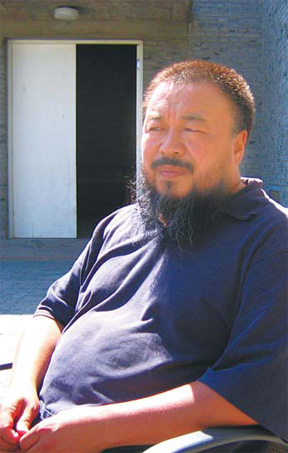An urban village on the outskirts of Beijing is emerging as one of the nation's artistic hotbeds.
Less then a decade ago, Caochangdi had virtually no arts presence but now 20 galleries and another 20 cultural enterprises, including arts organizations, studios, museums and art schools, operate within or near the village. And the galleries are top-notch.
Art Basel, among the world's most prominent contemporary art exhibitions, selects 200 to 300 galleries from around the globe to participate in its main fair. This year, at the 40th Art Basel, only four Chinese galleries made the cut, three of them from Caochangdi - Boers-Li Gallery, ShanghART and Galerie Urs Meile. The fourth Chinese gallery chosen was Long March Space from 798 Art Zone.
"There's quite a bit of concentration of people in the creative industries, from architecture, modern dance, documentary filmmaking and art galleries to artist studio spaces, antique dealers and, of course, the National Film Museum," says Meg Maggio, director of Caochangdi's Pekin Fine Arts gallery.
Robert Mangurian and Mary-Ann Ray, authors of Caochangdi, Beijing, Inside Out, list 46 arts and cultural enterprises around the village.
 |
|
Artist Ai Weiwei has turned Caochangdi into one of China's artistic hotbeds. [Mu Qian] |
Ai Weiwei, the first prominent artist to move to the village, was a catalyst in turning the area into an arts haven, says Mangurian and Ray, who also operate BASE (Beijing Architecture Studio Enterprise), an experimental architecture center in Caochangdi.
Ai built his first studio in the village - located near the Fifth Ring Road, 20km north of the city center - in 1999, attracted by the space needed for contemporary art and the relatively affordable rent in such an outlying area. Ai has since designed or built many of other galleries and studios in the area.
Maggio sees the village's growth as part of a larger trend of artists moving to the northeastern part of Beijing, spurred by the Central Academy of Fine Arts' (CAFA) relocation from the downtown Wangfujing area to the Wangjing area.
The village was a grazing land centuries ago, then an imperial hunting ground and later a royal graveyard complete with extensive, reputedly beautiful gardens.
In the 1960s the imperial gardens and the villagers who tended them were converted into an agricultural commune during the "cultural revolution" (1966-76).
The southern part of the village became an office park in the early years of China's reform and opening up.
Many of the different industrial-style buildings from those days are still occupied by foreign and domestic companies.
The unused ones provide the kind of space that attracts Ai and other contemporary artists.
The Boers-Li Gallery, for instance, was once a fishpond, which was later covered. It now resembles a huge, empty ice rink.
"One of the things I think about what makes Caochangdi unique is that we have very interesting and unorthodox space with enough room to breathe. The spaces are interesting and innovative and more sort of quiet and thoughtful," says Maggio.
Caochangdi's experimental gallery spaces and lack of noise have combined to make a good environment for contemporary art, according to Pi Li, a co-founder of Boers-Li.
"The main thing here is that it's not so touristy," says Pi.
"This is a place where people do things," says Robert Bernell, publisher of Caochangdi, Beijing, Inside Out.
"A lot of galleries here are project-based. They do projects. And yes, they do sell them but primarily everything is about doing, thinking and a lot less about selling. I think for people in the art world, curators, that's a lot more interesting than seeing paintings hung on walls with price tags underneath."
Affordable rent and longer-term 20-year leases are another draw.
The village's diverse population - locals, migrant Chinese and foreigners - creates an atmosphere that encourages innovative thinking, says Ray.
"It has a vibe, an energy that is full of life and creative production," she says. Local villagers, for instance, inspired by Ai's designs, are building their own shanzhai, or cottage industry-style imitations.
Caochangdi's colorful mix of people and architecture evolved of its own accord and can't be replicated elsewhere, says Mangurian. It's impossible to plan, build and designate a spot for creativity, he says. "But a place like Caochangdi is naturally spawning it."
(China Daily September 3, 2009)